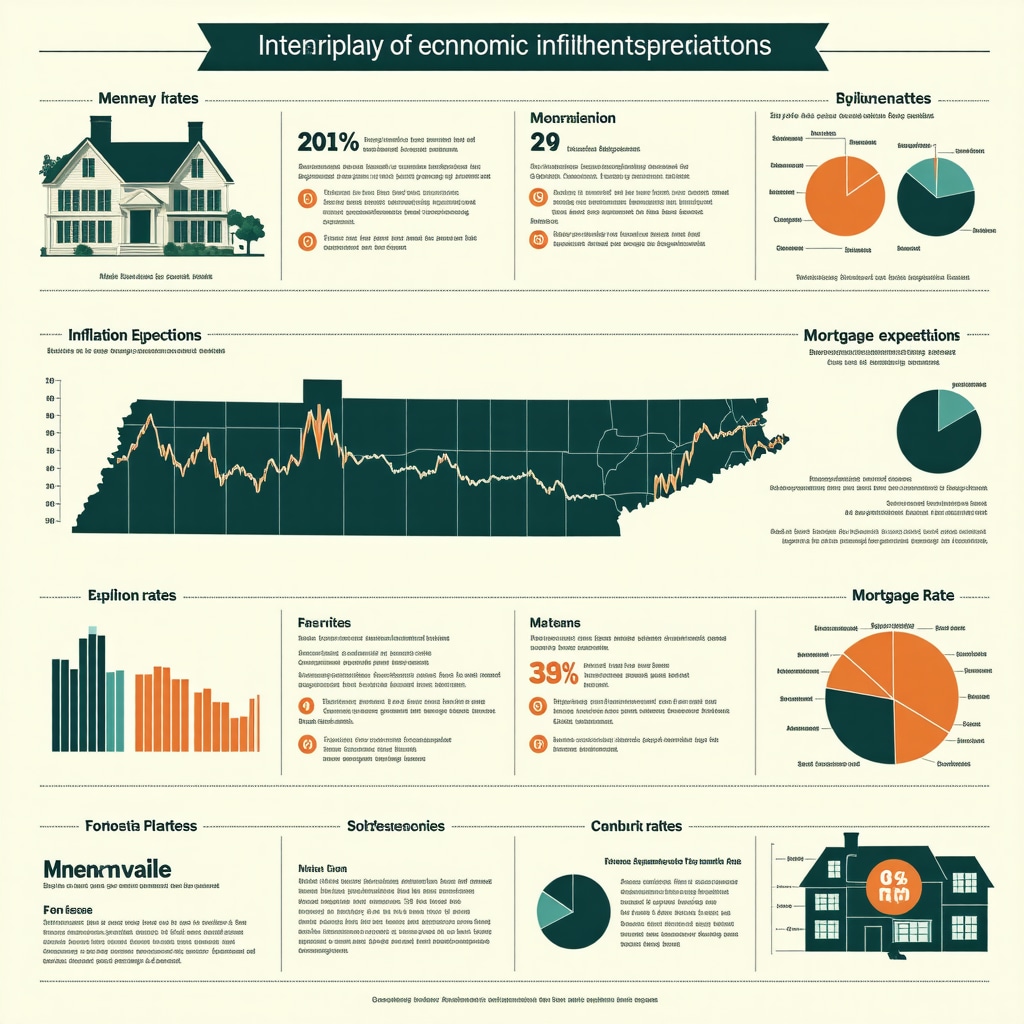Understanding Tennessee’s 30 Year Mortgage Landscape: What Buyers Need to Know
As we step into 2025, Tennessee’s housing market continues to captivate potential homebuyers and investors alike. Central to this dynamic is the 30 year mortgage rate, a critical factor influencing affordability and long-term financial planning. Unlike shorter-term loans, the 30 year mortgage offers the appeal of lower monthly payments spread over three decades, but its rates are sensitive to both national economic trends and regional market forces. Navigating these complexities requires an expert lens into current trends and future forecasts.
Decoding the Trends: How Have 30 Year Mortgage Rates Evolved in Tennessee?
Recent data reveals that Tennessee’s 30 year mortgage rates have experienced moderate fluctuations, mirroring broader shifts in the U.S. economy. Factors such as Federal Reserve policies, inflation expectations, and housing demand have interplayed to influence these rates. For instance, rising inflationary pressures in late 2024 prompted lenders to adjust rates upward to maintain profitability. Yet, Tennessee’s relatively stable housing market and robust local economy have moderated extreme volatility often seen in more speculative regions.
Moreover, regional economic growth hubs like Nashville and Chattanooga continue to attract new residents, sustaining demand for mortgage financing. This localized demand contributes to a nuanced mortgage rate environment, with slight variations depending on city-specific factors. Understanding these subtleties empowers buyers to time their mortgage applications for optimal savings.
Forecasting 2025: What Will 30 Year Mortgage Rates Look Like in Tennessee?
Experts predict a cautiously optimistic outlook for Tennessee’s 30 year mortgage rates in 2025. According to the Mortgage Bankers Association’s latest projections, rates may hover in a range that balances inflation control with economic growth, potentially stabilizing between 6% and 7%. This forecast reflects expected steady Federal Reserve actions and a resilient housing market. However, unexpected macroeconomic events could alter this trajectory.
For homeowners and buyers, this means strategic timing and thorough comparison are more important than ever. Locking in rates during periods of temporary dips could yield significant lifetime savings. For practical guidance on refinancing timing, readers can explore when to lock for maximum savings.
How Do Credit Scores Influence 30 Year Mortgage Rates in Tennessee?
Credit scores remain a pivotal determinant of mortgage rates. In Tennessee’s market, borrowers with higher credit scores typically secure rates significantly below the average, translating into substantial savings over 30 years. This sensitivity underscores the need for prospective buyers to understand and improve their credit profiles before applying. For deeper insights, the detailed analysis of credit scores and mortgage interest rates offers valuable strategies.
Regional Nuances: Why Tennessee’s Mortgage Rates Differ From National Averages
While national trends set a baseline, Tennessee’s mortgage rates reflect unique local economic conditions. Factors such as state employment rates, real estate inventory, and regional lending competition create a distinct rate environment. For example, Memphis often presents slightly different rate dynamics compared to Knoxville or Nashville due to variations in housing demand and lender presence. Understanding these regional differences can help buyers target the best mortgage options tailored to their location.
Stay Ahead: Leveraging Expert Insights for Smart Mortgage Decisions
In a market as fluid as Tennessee’s, staying informed is key. Regularly consulting authoritative sources like the Mortgage Bankers Association can provide timely data and forecasts. Additionally, collaborating with knowledgeable local mortgage brokers familiar with Tennessee’s market intricacies can unlock better rates and loan terms. For those interested in exploring broker options, our guide to finding the best local experts is invaluable.
Curious about how these mortgage trends might impact your homebuying journey? Share your thoughts or questions below to join the conversation and stay connected with the latest Tennessee mortgage insights.
The Impact of Economic Indicators on Tennessee’s 30 Year Mortgage Rates
Understanding how broader economic indicators affect Tennessee’s 30 year mortgage rates is essential for buyers and investors aiming to optimize their financing strategy. Key metrics such as GDP growth, unemployment rates, and consumer confidence levels indirectly influence mortgage lenders’ appetite and pricing models. For example, a robust Tennessee economy with low unemployment often correlates with stable or slightly rising mortgage rates due to increased borrowing demand. Conversely, economic slowdowns might prompt lenders to offer more competitive rates to stimulate borrowing.
Additionally, inflation plays a critical role. Persistent inflationary pressures can lead the Federal Reserve to tighten monetary policy, raising benchmark interest rates that trickle down to mortgage products. Keeping abreast of Tennessee’s local economic reports can provide early signals of mortgage rate movements, empowering buyers to act proactively.
What Are the Hidden Costs Beyond the 30 Year Mortgage Rate in Tennessee?
While the headline interest rate grabs attention, savvy Tennessee buyers recognize that numerous ancillary costs impact the overall affordability of a mortgage. These include origination fees, discount points, closing costs, and mortgage insurance premiums. For example, some lenders might offer a seemingly attractive 30 year mortgage rate but compensate with higher broker fees or underwriting charges.
It’s crucial to compare the Annual Percentage Rate (APR), which encapsulates both the interest rate and associated fees, to gain a holistic view of the loan’s cost. For an in-depth understanding of these fees and how they compare across Tennessee lenders, our comprehensive guide to mortgage broker fees is an excellent resource.
How Does Tennessee’s Housing Inventory Influence 30 Year Mortgage Rates?
Housing inventory levels in Tennessee significantly affect mortgage rate trends. Tight inventory, especially in high-demand markets like Nashville or Knoxville, often drives home prices upward, which in turn influences loan-to-value (LTV) ratios. Higher home prices with similar down payments result in higher loan amounts, sometimes pushing borrowers into different rate tiers or loan products.
Lenders may adjust rates based on perceived risk associated with loan size relative to property value. Consequently, buyers in markets with limited inventory should carefully evaluate mortgage options and consider strategies such as increasing down payments or exploring adjustable-rate mortgages. For detailed guidance on fixed versus adjustable mortgages in Tennessee, consult this expert guide.
Expert Strategies to Maximize Savings on Tennessee 30 Year Mortgages
Experienced Tennessee homebuyers employ several advanced tactics to secure lower 30 year mortgage rates. One effective approach is rate shopping across multiple lenders, including local banks, credit unions, and mortgage brokers. Each may present unique offers or incentives tailored to Tennessee’s market conditions.
Another strategy involves improving creditworthiness before application. Enhancing your credit score by addressing outstanding debts and correcting errors can translate into rate reductions, as documented extensively in the credit improvement guide.
Finally, timing the rate lock is critical. Locking in a rate during a favorable dip can protect against upward swings during the loan processing period. For more on timing your rate lock in Tennessee, check when to lock for maximum savings.
Can Local Tennessee Market Trends Predict Future Mortgage Rate Movements?
Market experts often debate the predictive power of local housing trends on mortgage rate fluctuations. In Tennessee, rising home sales volume and price appreciation in metros like Memphis or Chattanooga can indicate increased borrowing demand, potentially nudging mortgage rates higher due to lender risk assessments. Conversely, a slowdown in local sales or an increase in housing inventory may prompt rate stabilization or minor declines.
However, local trends are just one piece of the puzzle, as national macroeconomic policies and global financial conditions wield significant influence. Hence, while monitoring Tennessee’s housing market is invaluable, combining this with an understanding of broader economic forces yields the most reliable forecasting.
For continual updates and expert analysis on Tennessee mortgage rates and market trends, the Mortgage Bankers Association offers authoritative insights here.
If you’ve found these insights helpful, please share this article with fellow Tennessee homebuyers or leave a comment below with your questions or experiences navigating 30 year mortgage rates in Tennessee. For personalized assistance, consider reaching out through our contact page.
Deciphering the Role of Inflation Expectations in Tennessee Mortgage Rate Volatility
Inflation expectations profoundly shape the trajectory of 30 year mortgage rates in Tennessee. When consumers and investors anticipate rising inflation, lenders preemptively increase rates to offset the erosion of purchasing power over the loan’s lifespan. This phenomenon is particularly relevant in Tennessee’s diverse economic landscape, where sectors like manufacturing and healthcare contribute variably to price pressures.
Moreover, the Federal Reserve’s inflation targeting policies, communicated through forward guidance, influence mortgage lenders’ risk assessments. For instance, if the Fed signals a commitment to maintaining inflation around 2%, markets may stabilize, tempering mortgage rate spikes. Conversely, persistent inflation fears can trigger rate hikes even before official policy changes take effect.
Understanding these dynamics enables Tennessee homebuyers to anticipate rate movements beyond headline economic reports, incorporating nuanced inflation signals from local commodity prices, wage growth trends, and housing demand shifts. For those interested in an authoritative economic framework, the Federal Reserve’s Monetary Policy Overview offers critical insights.
Harnessing Data Analytics: Predictive Modeling for Tennessee Mortgage Rate Trends
The integration of advanced data analytics and machine learning models has transformed how lenders and buyers forecast mortgage rates. In Tennessee, leveraging localized datasets—such as regional employment figures, housing turnover rates, and credit default statistics—enables predictive models to generate more accurate rate forecasts tailored to specific cities or counties.
For example, machine learning algorithms can detect subtle patterns in Nashville’s housing market cycles, signaling optimal windows for locking in lower 30 year mortgage rates. These models also account for macroeconomic indicators, creating a holistic picture that transcends traditional forecasting methods.
Buyers with access to such data-driven insights can strategically time their mortgage applications, potentially saving thousands over the loan term. Collaborating with mortgage brokers who utilize these technologies can provide a competitive advantage in Tennessee’s evolving market.
How Can Tennessee Homebuyers Leverage Economic Indicators to Time Their Mortgage Rate Locks?
Timing a mortgage rate lock is a nuanced decision influenced by multiple economic signals. Tennessee buyers should monitor indicators such as the Consumer Price Index (CPI), employment reports, and Federal Reserve announcements, as these collectively impact lender risk premiums and rate adjustments.
For instance, a downward revision in local unemployment rates combined with steady CPI readings may suggest stable or declining mortgage rates, indicating a favorable locking opportunity. Conversely, unexpected inflation upticks or geopolitical tensions can precipitate abrupt rate increases, making early locks prudent.
Engaging with mortgage professionals who provide real-time analysis and personalized advice can help navigate these complexities effectively.
Exploring the Impact of Regulatory Changes on Tennessee’s 30 Year Mortgage Market
Recent and upcoming regulatory shifts at both federal and state levels are poised to influence Tennessee’s mortgage landscape. Changes in lending standards, disclosure requirements, and consumer protection laws affect lender underwriting criteria and pricing models.
For example, tighter Qualified Mortgage (QM) rules may restrict certain high-risk loans, potentially narrowing options for some buyers but enhancing overall market stability. Tennessee-specific legislation targeting foreclosure processes or property tax assessments can also indirectly impact mortgage affordability and lender risk calculations.
Keeping abreast of these regulatory developments is essential for buyers aiming to anticipate market shifts and optimize their financing strategies.
Integrating Sustainable Financing Options Within Tennessee’s 30 Year Mortgage Framework
The growing emphasis on sustainability has introduced new financing avenues that intersect with traditional 30 year mortgage products. Energy-efficient home loans and green mortgage programs offer incentives for buyers investing in environmentally friendly properties or upgrades.
In Tennessee, programs like the Tennessee Valley Authority’s energy efficiency financing complement conventional mortgages, potentially lowering overall borrowing costs through rebates or reduced interest rates. Incorporating these options requires a sophisticated understanding of eligibility criteria and lender partnerships.
For buyers committed to sustainable homeownership, integrating these financial products can enhance long-term value and contribute to statewide environmental goals.
To explore how these advanced strategies can be tailored to your specific situation, consult with our expert mortgage advisors through our contact page. Stay informed and empowered as you navigate Tennessee’s complex mortgage landscape in 2025 and beyond.

Harnessing Predictive Analytics to Navigate Tennessee Mortgage Rate Volatility
In the contemporary financial landscape, Tennessee homebuyers and lenders increasingly rely on sophisticated predictive analytics to decode the complexities of 30 year mortgage rate fluctuations. By integrating granular local economic data—such as employment trends, housing turnover velocities, and credit risk indices—machine learning models provide nuanced forecasts tailored to metropolitan areas like Nashville, Memphis, and Knoxville. These data-driven insights empower borrowers to identify optimal windows for rate locking, thus mitigating long-term financing costs in an environment often clouded by macroeconomic uncertainties.
Inflation Expectations: The Underestimated Catalyst Shaping Mortgage Rate Trajectories
Beyond headline economic indicators, inflation expectations exert a profound and often underappreciated influence on mortgage rate dynamics within Tennessee. Anticipated inflationary pressures compel lenders to adjust their risk premiums preemptively, especially given the fixed nature of 30 year loans where purchasing power erosion over decades is a tangible concern. This is particularly salient in Tennessee’s heterogeneous economy, where sectors such as advanced manufacturing and healthcare services contribute to differentiated regional inflationary trends. Consequently, understanding the interplay between local wage growth, commodity price shifts, and Federal Reserve forward guidance is indispensable for sophisticated mortgage planning.
How Can Tennessee Homebuyers Leverage Economic Indicators to Time Their Mortgage Rate Locks?
Optimal timing of mortgage rate locks requires a multifactorial analysis of economic indicators. Prospective Tennessee borrowers should vigilantly track variables like the Consumer Price Index (CPI), state-specific employment data, and Federal Reserve communications. For instance, a scenario featuring stable or declining local unemployment combined with steady inflation figures may signal an advantageous period to lock rates before prospective hikes. Conversely, unexpected inflation surges or geopolitical disruptions necessitate expedited locking strategies to hedge against rising costs. Partnering with mortgage professionals versed in real-time data analytics can substantially augment decision-making efficacy.
Regulatory Shifts and Their Strategic Implications on Tennessee’s Mortgage Market
Recent regulatory developments at federal and Tennessee state levels have introduced nuanced complexities into mortgage underwriting and pricing frameworks. Enhanced Qualified Mortgage (QM) standards aim to fortify borrower protections but simultaneously constrain certain high-risk loan products, effectively altering the competitive landscape. Tennessee-specific statutes impacting foreclosure procedures and property tax assessments further modulate lender risk calculations and affordability metrics. Staying abreast of these evolving regulations is critical for buyers seeking to optimize financing structures within the state’s unique legal milieu.
Integrating Sustainable Financing Mechanisms into Tennessee’s Mortgage Ecosystem
The burgeoning emphasis on environmental stewardship has catalyzed the incorporation of green financing instruments into Tennessee’s traditional 30 year mortgage offerings. Programs such as the Tennessee Valley Authority’s energy efficiency loans incentivize sustainable homeownership by providing rebates and preferential interest rates for eco-conscious property investments. These innovative financing avenues require a deep understanding of eligibility nuances and lender collaboration to maximize benefits. Prospective buyers incorporating these options not only realize potential cost savings but also contribute to Tennessee’s broader environmental targets.
For an authoritative perspective on monetary policy influencing mortgage rates, consult the Federal Reserve’s Monetary Policy Overview.
Elevate your mortgage strategy by engaging with our expert advisors who harness advanced analytics and market intelligence tailored to Tennessee’s evolving landscape. Visit our contact page to unlock personalized guidance and stay ahead in 2025’s competitive mortgage environment.

Frequently Asked Questions (FAQ)
What factors primarily influence 30 year mortgage rates in Tennessee?
Several key factors shape Tennessee’s 30 year mortgage rates, including national economic indicators like Federal Reserve policy, inflation expectations, and GDP growth, as well as local dynamics such as employment rates, housing inventory, and regional demand. Lender competition and creditworthiness also play significant roles.
How does my credit score impact the mortgage rate I can secure in Tennessee?
Your credit score directly affects the interest rate offered by lenders. Higher scores typically qualify for lower rates, yielding substantial savings over the life of a 30 year mortgage. Improving credit before applying is a strategic move to enhance affordability.
Why do mortgage rates vary across different Tennessee cities?
Variations arise due to localized economic conditions, housing demand and supply imbalances, and lender competition. For instance, Nashville’s booming market may exhibit different rate patterns compared to Memphis or Knoxville, influencing loan terms and pricing.
What hidden costs should buyers be aware of beyond the headline mortgage rate?
Buyers should consider origination fees, discount points, closing costs, mortgage insurance, and other lender charges. Comparing the Annual Percentage Rate (APR) helps capture the full cost of borrowing beyond the nominal interest rate.
How can I time my mortgage rate lock to maximize savings in Tennessee?
Optimal timing involves monitoring economic indicators such as inflation data, employment reports, and Federal Reserve announcements. Locking rates during favorable dips or before anticipated hikes can protect against rising costs. Consulting mortgage professionals who use real-time analytics enhances timing decisions.
What impact do inflation expectations have on Tennessee mortgage rates?
Anticipated inflation causes lenders to increase rates preemptively to mitigate purchasing power erosion over 30 years. Local wage growth and commodity price trends further influence these expectations, making inflation a critical variable in rate volatility.
Are there sustainable financing options integrated with traditional 30 year mortgages in Tennessee?
Yes, programs like energy-efficient home loans and Tennessee Valley Authority’s green financing offer incentives such as rebates and lower rates for environmentally friendly properties, complementing conventional mortgages and promoting sustainable homeownership.
How do regulatory changes affect mortgage options and affordability in Tennessee?
Recent federal and state regulations, including Qualified Mortgage standards and foreclosure law updates, shape lender risk assessments and underwriting criteria. These changes can limit certain loan products but enhance market stability and borrower protection.
Can predictive analytics improve my mortgage rate forecast and decision-making?
Absolutely. Advanced data analytics and machine learning models incorporate local economic data to provide nuanced forecasts, helping buyers identify optimal rate lock windows and tailor financing strategies specific to Tennessee’s diverse markets.
What role does housing inventory play in determining mortgage rates?
Tight inventory in high-demand Tennessee markets often raises home prices, affecting loan-to-value ratios and potentially pushing borrowers into higher rate tiers. Buyers should consider strategies like larger down payments or alternative loan products to mitigate risks.
Trusted External Sources
- Mortgage Bankers Association (MBA) – Provides comprehensive data, market forecasts, and policy analysis essential for understanding national and Tennessee-specific mortgage rate trends.
- Federal Reserve Board – Monetary Policy Overview – Offers authoritative insights into interest rate decisions and inflation management, directly impacting mortgage lending rates.
- Tennessee Valley Authority (TVA) – Details energy efficiency financing programs that intersect with mortgage options for sustainable homeownership in Tennessee.
- Tennessee Housing Development Agency (THDA) – Supplies localized housing market data, affordability metrics, and regulatory updates relevant to Tennessee borrowers.
- National Association of Realtors (NAR) – Provides in-depth reports on housing inventory, price trends, and regional market analyses that influence mortgage demand and pricing.
Conclusion
Navigating Tennessee’s 30 year mortgage rate landscape in 2025 demands a sophisticated understanding of both macroeconomic forces and local market nuances. From credit scores and housing inventory to inflation expectations and regulatory shifts, each factor plays a pivotal role in shaping mortgage affordability and borrower options. Leveraging advanced predictive analytics, staying informed through trusted sources, and engaging expert mortgage advisors empower buyers to make strategic decisions that optimize long-term financial outcomes. Whether you’re a first-time homebuyer or seasoned investor, integrating these insights will help you secure favorable mortgage terms tailored to Tennessee’s evolving market.
We invite you to share your experiences, ask questions, or explore our related expert content to deepen your knowledge. Stay proactive, informed, and confident as you embark on your Tennessee home financing journey in 2025 and beyond.

